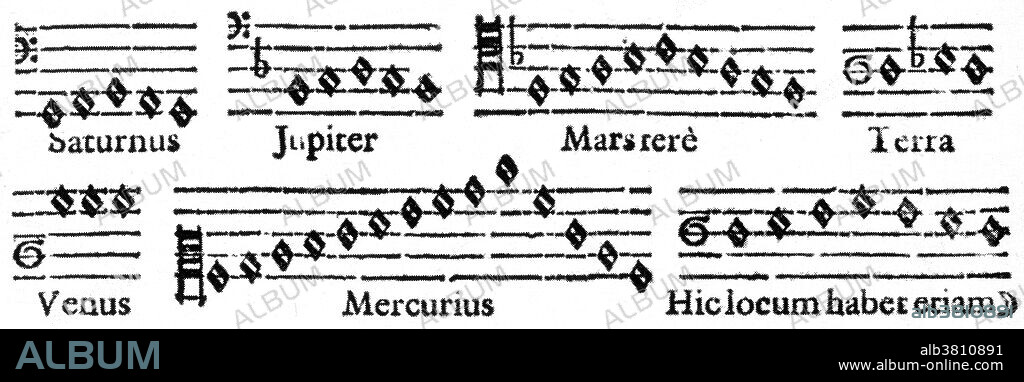alb3810891
Harmony of the World, 1619

|
Add to another lightbox |
|
Add to another lightbox |



Buy this image.
Select the use:

Title:
Harmony of the World, 1619
Caption:
In Harmonices Mundi (1619) Kepler attempted to explain the harmony of the world and contained what is known today as his third law. The work was founded on geometry, from which Kepler derived first a theory of musical harmony and then a cosmology of the heavens and the earth. Kepler attempted to find common rules between music and movement in the solar system. His music of the spheres is based on the relative maximum and minimum angular velocities of the planet measured from the sun. Using his theories, Kepler allotted to the planets musical intervals and musical motion. Johannes Kepler (1571-1630) was a German mathematician, astronomer and astrologer. A key figure in the 17th century scientific revolution, he is best known for his laws of planetary motion based on his works Astronomia nova, Harmonices Mundi, and Epitome of Copernican Astronomy. These works also provided one of the foundations for Isaac Newton's theory of universal gravitation.
Category:
Science: History
Credit:
Album / Science Source / New York Public Library
Releases:
Image size:
5529 x 1774 px | 28.1 MB
Print size:
46.8 x 15.0 cm | 18.4 x 5.9 in (300 dpi)
Keywords:
1571 • 16 16TH XVI XVITH SIXTEENTH CENTURY • 16 CENTURY • 1630 • 16TH CENTURY • 16TH • 17TH CENTURY • ART • ARTWORK • ASTROLOGIA • ASTROLOGIST • ASTROLOGY • ASTRONOMER • ASTRONOMIA NOVA • ASTRONOMIA • ASTRONOMY • ASTRONOMY: OBSERVATORY • CELEBRITIES • CELEBRITY • CLOSER TO SUN • COPERNICAN ASTRONOMY • DRAWING • ELLIPTICAL PATHS • ENGRAVING • EPITOME ASTRONOMIAE COPERNICANAE • EPITOME OF COPERNICAN ASTRONOMY • EUROPEA • EUROPEAN • EUROPEANS • FAMOUS PEOPLE • FAMOUS • FASTER IT MOVES • FUNDAMENTAL • GERMAN • GERMANS • HARMONICES MUNDI • HISTORIC • HISTORICAL • HISTORY • ILLUSTRATION • ILLUSTRATIONS • ILUSTRATION • IMPORTANT • J. KEPLER • JOHANNES KEPLER • KEPLER • LAWS OF PLANETARY MOTION • MATH • MATHEMATIC • MATHEMATICAL • MATHEMATICIAN • MATHEMATICS • NOTABLE • OBSERVATORY • ORRERY • PLANETARIUM • PLANETARY • PLANETS ORBIT THE SUN • PLANETS • PORTAIT • PORTRAIT • POTRAIT • SAVANT • SCIENCE • SCIENCE: HISTORY • SCIENTIFIC REVOLUTION • SCIENTIFIC • SCIENTIST • WELL-KNOWN • XVI CENTURY
 Pinterest
Pinterest Twitter
Twitter Facebook
Facebook Copy link
Copy link Email
Email
